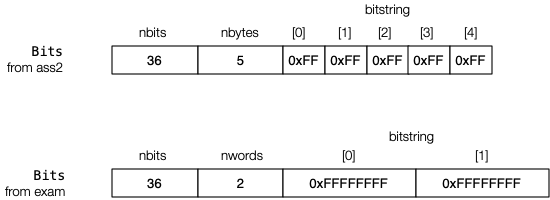Question 3 (20 marks)
In Assignment 2, you wrote signature-based indexing schemes. A critical component of these was a Bits ADT for arbitrary-length bit-strings. In the Assignment, the implementation of bit-strings was based on an array of 8-bit bytes. In this question, we plan to re-implement the Bits ADT so that it uses an array of 32-bit words (unsigned int) to hold the bit-string. The following diagram shows the difference between the two implementations:

Note that all of the bits (40 in the byte-based version, 64 in the word-based implementation) are set to 1, even though only 36 bits are required. The value of the "extra" bits is irrelevant, since these bits should be ignored, and only bits 0..nbits-1 should be accessed.
We have supplied a partly complete implementation of the Bits data type in the file bits.c. This contains seven functions, four of which are complete:
- newBits(int n) ... creates a new Bits object containing nbits bits
- freeBits(Bits b) ... releases memory associated with a Bits object
- setBit(Bits b, int i) ... set the ith bit in bit-string b to 1 (0 ≤ i < nbits)
- setAllBits(Bits b) ... set all bits in the bit-string to 1
- unsetBit(Bits b, int i) ... set the ith bit in bit-string b to 0 (0 ≤ i < nbits)
- unsetAllBits(Bits b) ... set all bits in the bit-string to 0
- showBits(Bits b) ... display a Bits object as a sequence of 1's and 0's
The functions newBits(), freeBits(), setAllBits(), and unsertAllBits() are complete and you should not modify them. Note that setAllBits() sets all bits in the bitstring array, even though not all of them are used. You should ignore the "extra" unused bits.
Your task: you must complete the setBit(), unsetBit() and showBits() functions. Note that showBits() should show only the nbits bits in the bit-string, in the order nbits-1 .. 0.
Like the assignment, the words in the array contain the low-order bits in bitstring[0], up to the high-order bits in bitstring[nwords-1] Within a Word, the low-order bits are at the right-hand end of the Word and the higher-order bits are at the left-hand end.
To test the Bits ADT, we have supplied a driver command called ./bs (in the file bs.c). The ./bs command is invoked as follows:
$ ./bs Nbits +|- mods
where Nbits is (suprise!) the number of bits in the bit-string. The second argument can be "+", in which case all bits are initially set to 1, or "-", in which case all bits are initially set to 0. This can be followed by an arbitrary number of modifiers. Each modifier contains a bit position, preceded by "+" or "-". If "+", the specified bit i set to 1; if "-", the specified bit is set to 0.
An example:
$ ./bs 40 + -10 -20 -30 +20 init: 1111111111111111111111111111111111111111 -010: 1111111111111111111111111111101111111111 -020: 1111111111111111111011111111101111111111 -030: 1111111110111111111011111111101111111111 +020: 1111111110111111111111111111101111111111
This creates a 40-bit bit-string and initialises all 40 bits to 1. It then displays this as the inital (init:) value, using showBits(). It then unsets bits 10, 20 and 30 before setting bit 20 back to 1. After each modification, it displays the mod and then displays the modified bit-string (using showBits()).
The argument processing and display of each mod is handled from within bs.c, whose code you should not change.
There are other examples of using ./bs in the tests directory. You should also be able to devise your own test cases easily enough.
To help you check whether your program is working correctly, there is a script called run_tests.sh which will run the program against all of the tests and report the results. It will also add the output from your program into the tests directory; comparing your output against the expected output might help you to debug your code. You can run the testing script as:
$ sh run_tests.sh
Once your function is working (passes all tests), follow the submission instructions below. Even if it fails some (or even all) tests, you should submit because you can get some marks. If your program does not compile, or if you simply submit the supplied code, then your "answer" is worth zero marks.
Submission Instructions:
- Type your answer to this question into the file called bits.c
- Submit via: give cs9315 exam_q3 bits.c
or via: Webcms3 > exams > Final Exam > Q3 submission > Make Submission